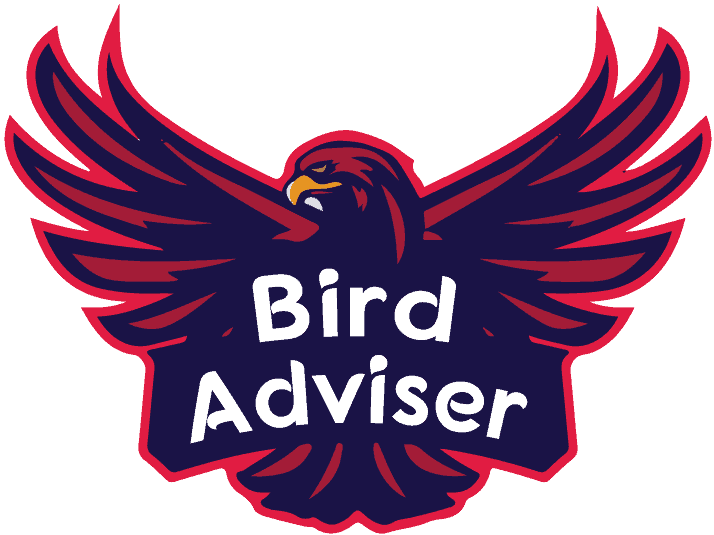Hello, fellow nature enthusiasts,
If you’re like me and love to witness the mesmerizing sight of hummingbirds hovering and sipping nectar, then you’ve probably considered hanging a hummingbird feeder.
However, you might be wondering, “Where is the best place to hang a hummingbird feeder to attract these delightful creatures?”
Look no further!
In this article, I’ll share the four best locations to hang your hummingbird feeder and ensure you have a front-row seat to the dazzling display of these tiny wonders.
Let’s dive in and make your garden a hummingbird hotspot!
Best Places to Hang Hummingbird Feeders
Here are the best locations where you may put your hummingbird feeders:
1. Trees
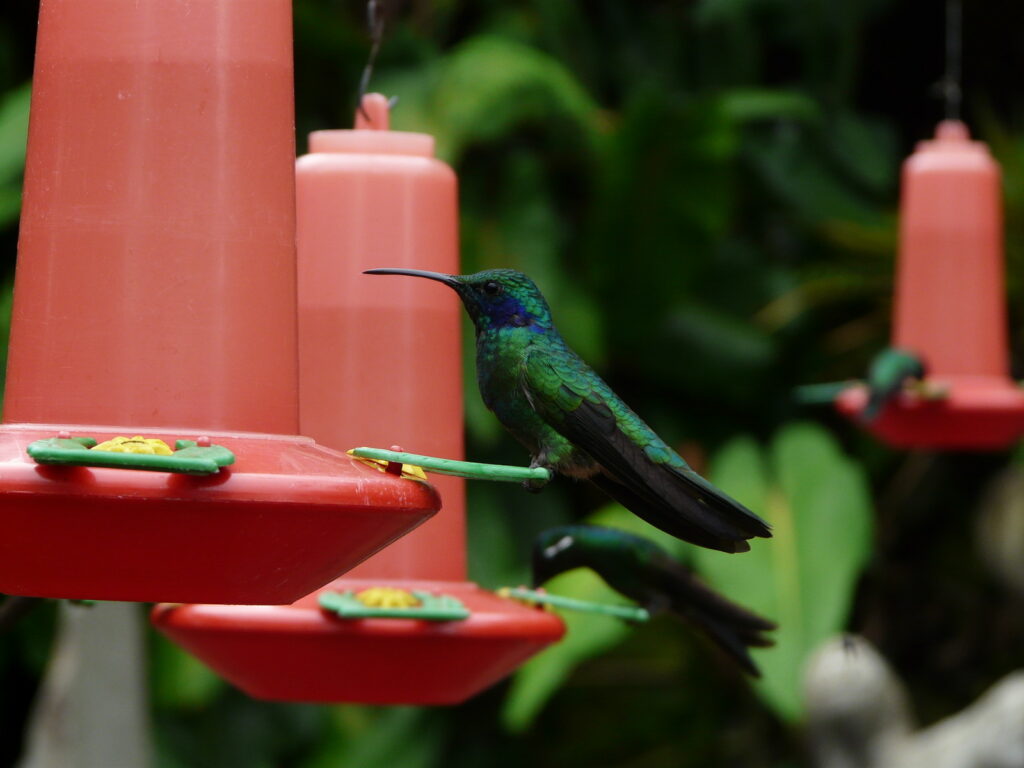
Hummingbirds may eat up to twice their body weight, although they spend at least 80% of their eating period perched.
They like taking a break from the hard flapping while taking in the scenery.
As a result, tying the feeder to trees is a fantastic idea.
Trees are also beneficial since they provide a haven for your feathered companions if a predator appears.
If your trees are near brilliantly colored flowers, the blooms’ nectar can help augment the nectar you supply.
Because most hummingbird feeders come with a loop, hanging one on a tree limb is simple.
Make sure the nectar feeder is free of insects and other tiny animals.
2. Poles
Poles are a terrific solution when you don’t have any trees in your yard.
They’re also great for scaring squirrels away, especially if you need to treat other species with bird seed.
With a metal pole, you may modify the height as needed and add additional perches to accommodate as many hummingbirds as you could approach your feeder.
Planting the feeder up to 8 feet tall will deter other animals from getting to it.
Unlike a tree, you may relocate a pole to a location where the hummers can see it and where you can see your feathered friends well.
If you are looking for a recommendation for Heavy Duty, High-Quality Outdoor Pole, then check this pole out on Amazon.
3. Window
A bird feeder beside a window would not be the most fantastic spot to put one in your yard.
The hummingbirds may be seen feeding on the window.
However, putting the feeders close to a window raises the likelihood of crashes since the birds may not see through the glass.
To make it simple for you to see your birds from your house, place your feeder at least 5 feet away from the window and no more than fifteen feet away.
If you are looking for a recommendation for Good Quality Window Hummingbird Feeder, then check this one out on Amazon.
4. Shade or Sunlight
To guarantee that the nectar does not go bad rapidly, you must first set your feeders in the shade.
During the day, however, you must set the feeder in bright sunshine to ensure that it sparkles and attracts hummers.
Having the feeder out in the open allows the birds to see it during the day.
It is the ideal option if you can put the feeder in the shade while still allowing the birds to see it.
If you are looking for a recommendation for High-Quality Hummingbird Feeder with Shade then check this one out on Amazon.
Factors to be Considered for Hummingbird Feeder Location
1. Hummingbird Feeders Should be Easily Accessible to the Birds
Your feeders should be extremely visible, especially early in the spring.
As a result, any passing hummingbirds will notice your feeders and come to drink from them.
Your feeders should be hung high and out in the open.
You can relocate hummingbirds to a more isolated or shaded spot if they become a frequent visitor.
Hummingbirds will be attracted to your yard if you use bright red, orange, and yellow ribbons or decorations.
2. Hummingbird Feeders Should be Positioned within 10-15 Feet of the Shield
Hummingbird feeders should be hung near a shrub or tree where predators can hide.
Even if your feeders are in the center of the yard, they should be close to some form of protection.
Hummingbirds may not approach the feeder on a routine basis or stay for lengthy amounts of time if safety is too far away.
3. A Nearby Tall Survey Perch Attracts Hummingbirds
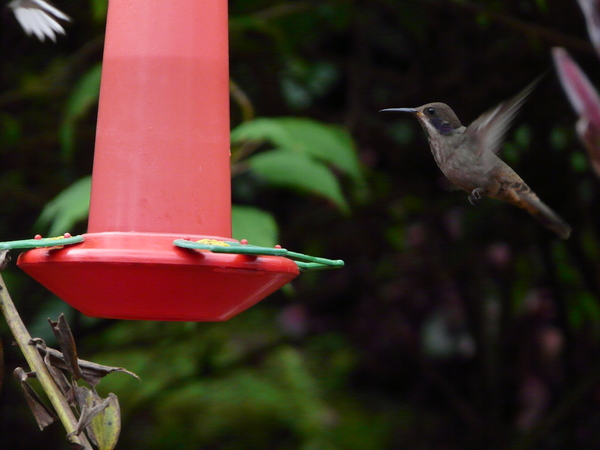
The hummingbird in charge maintains a close eye on the feeder.
He or she generally selects a vantage point far above with a commanding view.
It might be a bird feeder pole or a tree fence line.
Any intruders are chased away by this bird from there.
At a feeder, there is usually one dominating hummingbird that scares the others away. Or, at the very least, pursues them.
When there are more hummingbirds at the feeder, this aggressive bird has a harder time driving them away.
You may even add a hummingbird swing, which is a perch.
When the dominating hummingbird is not seeking other hummingbirds, place the perch within 5 or 6 feet of the feeder, and the dominating hummingbird will remain around all day.
The best thing is that you can position this swing so that you can have a wonderful view of your home.
4. Hummingbird Feeders Should Be Hung Where They Can be Seen
A hummingbird feeder’s goal is to bring hummingbirds into view.
Many folks use an existing hook to hang the hummingbird feeder.
However, seeing the feeder from inside your home may not be the best option.
This is the ideal location for the feeder.
How about later in the evening?
What room are you going to be in? Another ideal place for a feeder will be that room’s window.
5. Hummingbird Feeders Should be Placed in the Early Light and in the Afternoon Shade
That is the basic concept.
Hummingbirds may feel chilly in the morning and seek the warmth of the sun to eat.
The honey might spoil more quickly under the afternoon light.
6. Take Pictures of Hummingbirds at Feeders
Hummingbirds at your feeder should be photographed up close.
You want them to have front-facing sunshine on them.
The hummingbird will either be in the shadows or a silhouette staring directly into the light if you put a feeder just outside the window.
Put the feeders on the southern side of your home to lure hummingbirds in the mornings.
It should be around 5 to 6 feet away from the window and a little to the west of the window.
When photographing hummingbirds via a window, the image is frequently slightly distorted.
There are also reverberations.
As a result, position the camera against the window.
7. Maintaining and Replacing Hummingbird Feeders Must be Simple
Wherever you place your hummingbird feeders, make sure it’s simple to get to.
The feeders will deplete and have to be cleaned every 3-5 days during the summer.
To attract a big number of hummingbirds, hummingbird feeders must be maintained clean.
You won’t take them down if it’s difficult.
They’ll be empty or filled with hazy nectar that the hummingbirds won’t swallow.
8. Cats Must be Kept Away From Hummingbird Feeders
Cats can leap pretty far.
The biggest hazard to hummingbirds, however, is not leaping cats.
Cats pouncing from a hidden spot are more commonly the cause of bird fatalities.
So keep plants that are thick to the ground away from hummingbird feeders that are low hanging.
Remove any places where a cat may hide and pounce to a distance of at least 8 feet.
Alternatively, you may just suspend your hummingbird feeder 5 feet above the ground.
9. Feeders for Hummingbirds Should be Positioned Away from Windows
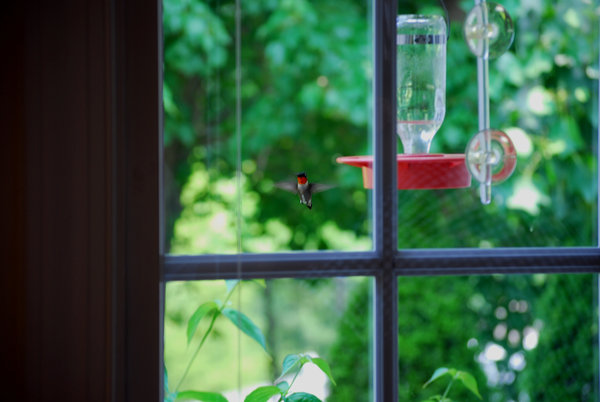
Birds are perplexed by windows.
They believe they can fly through it if it is clear.
Alternatively, they may be misled by the reflection into believing it is the sky.
Bird feeders, especially hummingbird feeders, should be placed at two different distances from windows.
Place your feeders far away from your house to avoid window damage.
Experts advocate a distance of at least 10 feet.
What’s the deal with them being so close?
Birds can see a window more readily if they are close to it, to begin with.
They won’t be hurt if they hit the window since they’re not flying fast enough.
They notice their own reflection and have enough time to avoid colliding head-on.
You may use decals on the glass to alert birds to the presence of something.
The form of the decals is less important than having something to focus on in the same plane as the glass.
Then, rather than gazing through, they may view the window glass itself.
10. Hummingbird Feeders Should Be Maintained Apart from Other Bird Feeders
Hummingbirds will appreciate some peace and quiet away from the commotion of other birds at the seed feeders.
Hummingbird feeders can be placed near other bird feeders, although hummingbirds are more likely to come if other birds do not scare them.
Hummingbirds will feel safer if there is a bit more space between them and other species at food feeders.
11. Multiple Hummingbird Feeders Should Be Spaced Out as Follows
There are two schools of thinking on how near numerous hummingbird feeders should be placed.
Some people advocate installing a second feeder around the corner, out of sight from the first, since there is typically a dominant bully hummingbird at the first feeder.
Less prominent birds are free to feed there.
Place many feeders close together if you wish to attract a big number of hummingbirds.
While one hummingbird is being chased away by the dominating hummingbird, the others can drink.
When the bully has had enough of pursuing, he shares the feeder.
When multiple feeders are hung together, however, everyone is pursuing everyone.
12. Allow Adequate Room around Hummingbird Feeders for the Birds to Fly Around Them
Hummingbirds frequently eat while flying.
They wouldn’t want the feeder too near to anything else.
Poles, plants, and other feeders must be at least a foot away from feeders.
Similarly, hummingbirds may be wary about visiting hummingbird feeders camouflaged under bushes.
Outside shrubs, with some open space around them, hang the feeder.
13. Plants Should Not be Allowed to Touch the Hummingbird Feeder
This suggestion is related to the preceding one.
Plants should be kept cut back from the hummingbird feeder.
Why? Ants access the feeder by crawling up the plants.
This negates the ant moat’s aim.
In the ant moat, always utilize and preserve water.
14. Feeders for Hummingbirds Should be Placed Out of the Breeze
The hummingbird feeder sways and leaks as a result of the wind.
Ants and bees are drawn to hummingbird feeders that leak.
Ants drawn to hummingbird feeders can eventually find their way into your home!
That’s not what you’re looking for.
Insects will be less of an issue for your residence if the hummingbird feeders are put on bird feeder poles in the yard.
Ants, on the other hand, may swiftly spoil hummingbird nectar.
15. Hummingbird Feeders Should be Hung Such that they Don’t Drop on Anything Important
You don’t want any sugar water leaks to go into your shoes.
The hummingbird feeder should not drip on your picnic table, grill, air conditioner, or decorations.
16. Hummingbird Feeders can be Hung in your Flower Garden
Hummingbird feeders look like blossom nectar!
As a result, attracting hummingbirds with blossoming flowers is a no-brainer.
When hummingbirds are around, there will always be some flowers.
Flowers with trumpet-shaped blooms are preferred by hummingbirds.
For details on native flowers that flourish in your region, contact your local nursery.
The greatest approach to attract hummingbirds to your yard is to plant flowers that they enjoy.
Best Ways to Hang Hummingbird Feeder
1. Using a Shepherd’s Hook or a Pole, Hang a Hummingbird Feeder
The most apparent approach to hanging a hummingbird feeder is from the ceiling.
The advantage of using a bird feeder pole is that you can place the feeder precisely where you want it in your yard.
My wife and I prefer an 84-inch tall, twin-offset shepherd’s hook from Home Depot for hanging all of our bird feeders.
It goes a foot or more into the earth. The feeders are hung at more than 5 feet in height.
On the Home Depot website, you may find this shepherd’s hook.
2. Hang from Eaves
Are there pegs for placing plant pots on your eaves? Perfect! Flowers can be hung on several of the hooks.
Place a hummingbird feeder on another hook between them.
Why not use hooks to hang flower baskets if you don’t have any?
Get some right now.
3. A Hummingbird Feeder Can Be Hung from a Window Awning
There are numerous advantages to putting a hummingbird feeder in this position.
Strong winds may also provide some protection.
It is also rain-protected.
The best part is that a bird feeder suspended from an awning is always visible from the window.
4. Hummingbird Feeders Can Be Hung from Rain Gutters
If your roof doesn’t allow for hummingbird feeders to be hung from the eaves, try the gutters.
There should be nothing too heavy dangling from the gutters, but a lightweight feeder should suffice.
5. Using a Shelf Bracket, Hang a Hummingbird Feeder on the Wall
A hummingbird feeder may be hung from the exterior of your home using a shelf bracket.
To prevent moisture out of the screw holes, you might wish to caulk using a silicone sealant.
To avoid anybody banging their head on the projecting shelf bracket, keep it above head height.
6. Using a Shelf Bracket Hanging from a Wooden Fence
A hummingbird feeder may be hung from a fence post or the top wooden rail using a shelf bracket.
An arm can alternatively be secured to the top of the pickets with a C-clamp. B
ut be sure to do it in a location where no one will run into the arm.
7. A Hummingbird Feeder Can be Tied to a Tree
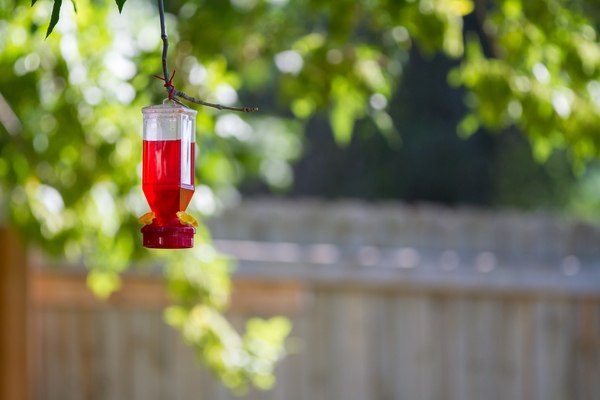
It is proposed to hang the feeder from a low tree branch so that it does not swing around excessively.
A string or small rope may be required for a higher limb.
A shelf bracket can be attached to the tree’s trunk.
Wood screws are used to secure the bark, which should be longer for thicker bark.
Because ants like to dwell in trees at particular seasons of the year, make sure you utilize an ant moat.
8. Hang a Hummingbird Feeder from a Gazebo
Hang feeders from eaves, or siding using the same installation technique as mentioned above.
9. Purchase a Suction-cup Window Hummingbird Feeder
Window feeders attract birds to come right up to you.
Hummingbird feeders that are connected to a window have a lesser capacity.
Furthermore, the suction cups can only support a lightweight feeder.
After a while, the suction cups usually pop off the glass.
Before you put the suction cups on the window, make sure it’s clean and dry.
They’ll stay for quite some time after that.
It’s vital to keep in mind that there are two separate groups.
Either the hummingbird feeder or the suction cups that hold it to the window.
Alternatively, you may remove the suction cups from the hanger and use a standard hanging bird feeder.
You may then hang any kind of bird feeder from your window.
10. Using an Extension Arm to Hang from a Wooden Deck Railing
Hummingbird feeders may be attached to your deck railing with extension arms and C-clamps.
These might also be used to secure the arm to a wooden fence’s upper rail.
Some work on metal railings as well.
11. From a Covered Porch or Deck, Hang your Bird Feeder
Hummingbird feeders may be hung from the eaves or gutters, just like in your house, as mentioned above.
If you are wondering when to put out Hummingbird Feeders? then check out this article.
Final Words
In conclusion, choosing the right location for your hummingbird feeder can make all the difference in attracting these enchanting birds to your garden.
Remember to keep the feeder clean and filled with fresh nectar to maintain their interest and ensure their well-being.
Be patient, as it may take some time for hummingbirds to discover and frequent your feeder.
But rest assured, with a little time and effort, your garden will become a haven for these jewel-like creatures.
So, get ready to witness the delightful dance of hummingbirds right before your eyes.
Hang your feeder strategically, sit back, and enjoy the show as these tiny wonders bring a touch of magic and beauty to your outdoor space.
Happy hummingbird watching!
FAQ
What's the best time of year to hang a hummingbird feeder?
The best time to hang a hummingbird feeder is during the spring and summer months when hummingbirds are most active and seeking reliable food sources. In some regions, they might arrive as early as late winter or early spring, so it’s a good idea to have your feeder ready by then.
How high should I hang my hummingbird feeder?
Ideally, hang your hummingbird feeder at eye level or slightly above, around 5 to 6 feet off the ground. This height makes it easier for you to observe these tiny birds up close and provides them with a comfortable feeding position.
Can I hang the feeder in direct sunlight?
While hummingbirds are attracted to bright colors and might spot the feeder in direct sunlight, it’s best to avoid hanging it there. The intense heat from direct sunlight can cause the nectar to spoil quickly, making it less appealing to the birds. Opt for a shaded spot instead, where the feeder is protected from the scorching sun.
Can I hang multiple feeders in my garden?
Absolutely! Hanging multiple feeders in different locations can attract more hummingbirds and reduce competition. Ensure that the feeders are placed at a sufficient distance from each other to avoid territorial disputes among the birds.
Can I hang the feeder close to flowers or windows?
Yes, hanging the feeder near blooming flowers or windows can be a great idea. The combination of natural flowers and the feeder’s bright colors will catch the attention of hummingbirds passing by. If placing it near a window, make sure there’s enough space for the birds to take off without hitting the glass.
Last Updated on July 28, 2023 by Lily Aldrin
